Podcast
Questions and Answers
What is microbiology?
What is microbiology?
- The study of animals
- The study of visible organisms with the naked eye
- The study of microscopic organisms requiring magnification (correct)
- The study of plants
Who was the first to report microorganisms and referred to them as 'Animalcules'?
Who was the first to report microorganisms and referred to them as 'Animalcules'?
Anton van Leeuwenhoek
Louis Pasteur disproved the theory of spontaneous generation with his experiments.
Louis Pasteur disproved the theory of spontaneous generation with his experiments.
True (A)
______ was identified as the solidifying agent used in culture media, proposed by Fannie Hesse.
______ was identified as the solidifying agent used in culture media, proposed by Fannie Hesse.
Match the individuals with their contributions:
Match the individuals with their contributions:
Flashcards are hidden until you start studying
Study Notes
Introduction to Microbiology
- Microbiology is the study of microorganisms, usually less than 1mm in diameter, which require some form of magnification to be seen clearly.
- Examples of microorganisms include viruses, bacteria, fungi, algae, and protozoans.
- Some microorganisms, such as bread molds and filamentous algae, can be visualized without amplification, but are still studied in microbiology due to similarities in properties and techniques used.
Historical Perspectives
- Early discoveries:
- Lucretius and Girolamo Fracastoro believed that invisible creatures were responsible for disease.
- Francesco Stelluti observed bees and weevils using a microscope in the early 1600s.
- Anton van Leeuwenhoek was the first to report microorganisms (Animalcules) in 1632-1723, using 50-300X magnification.
- Spontaneous Generation:
- Belief that life could originate from non-living or decomposing matter.
- Supported by Aristotle, John Needham, and Lazarro Spallanzani.
- Disproved by Francesco Redi, Schwann, Friedrich Schroder, and von Dusch, John Tyndall, and Louis Pasteur.
Role of Microorganisms in Disease
- Demonstrations that microorganisms cause disease:
- Agostino Bassi showed that a silkworm disease was caused by a fungus.
- M.J. Berkeley demonstrated that the Great Potato Blight of Ireland was caused by a fungus.
- Louis Pasteur showed that the pébrine disease of silkworms was caused by a protozoan parasite.
- Joseph Lister developed a system of surgery designed to prevent microorganisms from entering wounds, leading to a decrease in post-operative infections.
Development of Culture Media
- Why: To enable the isolation of pure cultures (only one type of organism).
- Gelatin was not useful as a solidifying agent, but agar was proposed by Fannie Hesse and used today.
- Richard Petri developed the Petri dish.
Development of Vaccines and Antisera
- Edward Jenner discovered that cowpox (vaccinia) induced protection against human smallpox.
- Vaccination: Inoculation of healthy individuals with weakened (or attenuated) forms of microorganisms to provide protection or active immunity from disease.
- Louis Pasteur and Roux developed vaccines, including attenuated anthrax and rabies vaccines.
How Microorganisms Affect Their Environment
- Louis Pasteur demonstrated that alcoholic fermentations were the result of microbial activity.
- Sergei Winogradsky worked with soil bacteria and discovered that they could oxidize iron, sulfur, and ammonia to obtain energy.
- Martinus Beijerinck isolated aerobic nitrogen-fixing soil bacteria and sulfate-reducing bacteria.
Microorganisms in the 20th Century
- Important early discoveries:
- George W. Beadle and Edward L. Tatum studied the relationship between genes and enzymes using the bread mold, Neurospora.
- Salvadore Luria and Max Delbruck demonstrated spontaneous gene mutations in bacteria.
- Oswald T. Avery, Colin M. MacLeod, and Maclyn McCarty provided evidence that DNA was the genetic material and carried genetic information during transformation.
- Microbiology has played a major role in molecular biology and has been closely tied to the determination of the genetic code.
Studying That Suits You
Use AI to generate personalized quizzes and flashcards to suit your learning preferences.




